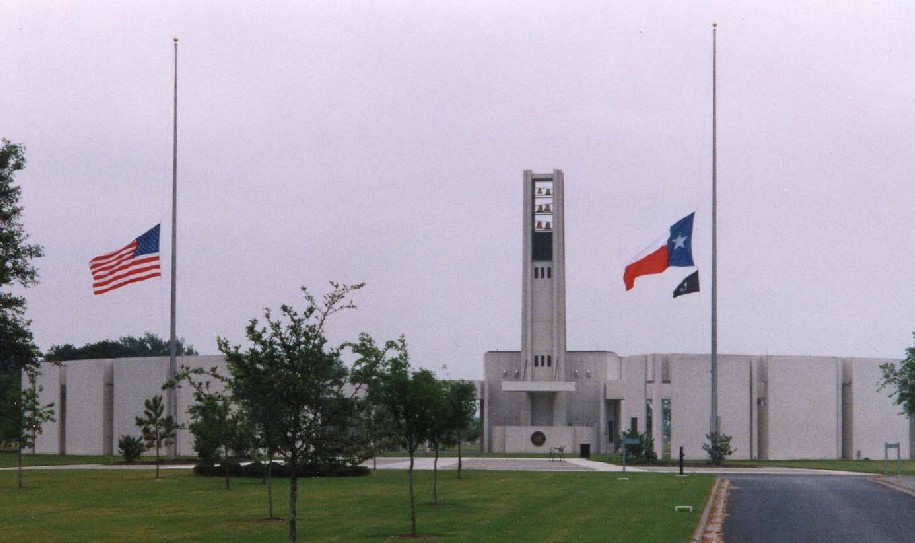|
Houston |
Office Hours: Visitation Hours: |
|
|
Burial Space: This cemetery has space available to accommodate casketed and cremated remains. Acreage: 419.2 |
|
Directions from
nearest airport: |
Military
Funeral Honors
In addition to the Department of Defense, the Veterans of Foreign Wars,
District 4, Memorial Detachment also provides military funeral honors.
This unit, made up primarily of World War II Veterans, provides the rifle
salute, a eulogy, the playing of "Taps," and the presentation
of the flag. Your local funeral home can make arrangements for these honors
on your behalf.
back to top
The Houston Veterans Administration Cemetery was dedicated Dec. 7, 1965. It was the only government cemetery constructed in the United States during the 1960s.
The present-day Houston National Cemetery was the largest of its kind at the time of construction. Designed entirely by VA staff, it was also the only new VA cemetery not located on the grounds of a VA hospital. Prior to Houston’s opening, the last VA cemetery established was at Eagle Point VA Medical Center, Ore., in 1952. The largest VA cemeteries at the time were in Los Angeles at 114.47 acres, and Leavenworth, Kan., at 113.15 acres. At 419.2 acres, the Houston facility was slightly smaller than the 450 acres or so of Arlington National Cemetery, to which it was compared.
Houston became a national cemetery in 1973 after the passage of the National Cemetery Act, when operations and management were transferred from the U.S. Army to the Veterans Administration.
Monuments
and Memorials
The Hemicycle at Houston National Cemetery is its largest memorial and
the most visible structure on the landscape. It is the only NCA-managed
hemicycle memorial and is one of only three known hemicycles located in
national cemeteries. The others are located at Arlington National Cemetery,
Va., operated by the U.S. Army, and at Manila American Cemetery and Memorial
in the Philippines, operated by the American Battle Monuments Commission.
At the keystone, or
center, of the hemicycle are the chapel, carillon and speaker’s
stand. David Parsons, a professor of art at Rice University, sculpted
a 20’ x 6’ bas relief of three interlocking forms—a
fallen soldier supported by two comrades. The sculpture, made of crushed
quartz, was installed at the chapel entrance in 1965. The 75-foot tower,
305-bell, Schulmerich “Americana” carillon was dedicated May
30, 1970.
back to top
NOTABLE
BURIALS
Medal of Honor Recipients
First Lieutenant Raymond L. Knight, (World War II), U.S. Army Air Corps.
Northern Po Valley, Italy, on April 25, 1945. His remains were relocated
to Houston National Cemetery on April 25, 1992 (Section H-B 11).
Staff Sergeant Marcario Garcia, (World War II), U.S. Army, Company B, 22nd Infantry, 4th Infantry Division. Grosshau, Germany, Nov. 27, 1944 (Section H-A 1).
Captain James H. Fields, (World War II), U.S. Army, 10th Armored Infantry, 4th Armored Division. Near Rechicourt, France, Sept. 27, 1944 (Section H-B 6).
Other
Burials
The most renowned
veteran buried in the cemetery is the late Honorable Albert Thomas, United
States Congressman from Texas. Congressman Thomas served as a Lieutenant
in the U.S. Army during World War I, and served almost 30 years in the
U.S. House of Representatives. He was instrumental in getting this cemetery
established by Congress. "Congressman Albert," as his many friends
knew him, died in Washington, D.C., on Feb. 15, 1966, and was buried in
the mall area of the Houston National Cemetery, on Feb. 18, 1966.
back to top
Cemetery policies are conspicuously posted and readily visible to the public.
Floral arrangements accompanying the casket or urn at the time of burial will be placed on the completed grave. Natural cut flowers may be placed on graves at any time of the year. They will be removed when they become unsightly or when it becomes necessary to facilitate cemetery operations such as mowing.
Artificial flowers and potted plants will be permitted on graves during periods when their presence will not interfere with grounds maintenance. As a general rule, artificial flowers and potted plants will be allowed on graves for a period extending 10 days before through 10 days after Easter Sunday and Memorial Day.
Christmas wreaths, grave blankets and other seasonal adornments may be placed on graves from Dec. 1 through Jan. 20. They may not be secured to headstones or markers.
Permanent plantings, statues, vigil lights, breakable objects and similar items are not permitted on the graves. The Department of Veterans Affairs does not permit adornments that are considered offensive, inconsistent with the dignity of the cemetery or considered hazardous to cemetery personnel. For example, items incorporating beads or wires may become entangled in mowers or other equipment and cause injury.
Permanent items removed
from graves will be placed in an inconspicuous holding area for one month
prior to disposal. Decorative items removed from graves remain the property
of the donor but are under the custodianship of the cemetery. If not retrieved
by the donor, they are then governed by the rules for disposal of federal
property.
back to top
VA Home Page /
Site Map /
Facilities Locator /
Privacy & Security Statement /
Disclaimer
Freedom of Information Act /
Contact the VA /
Accessibility Notice
Last Update: September 24, 2004


